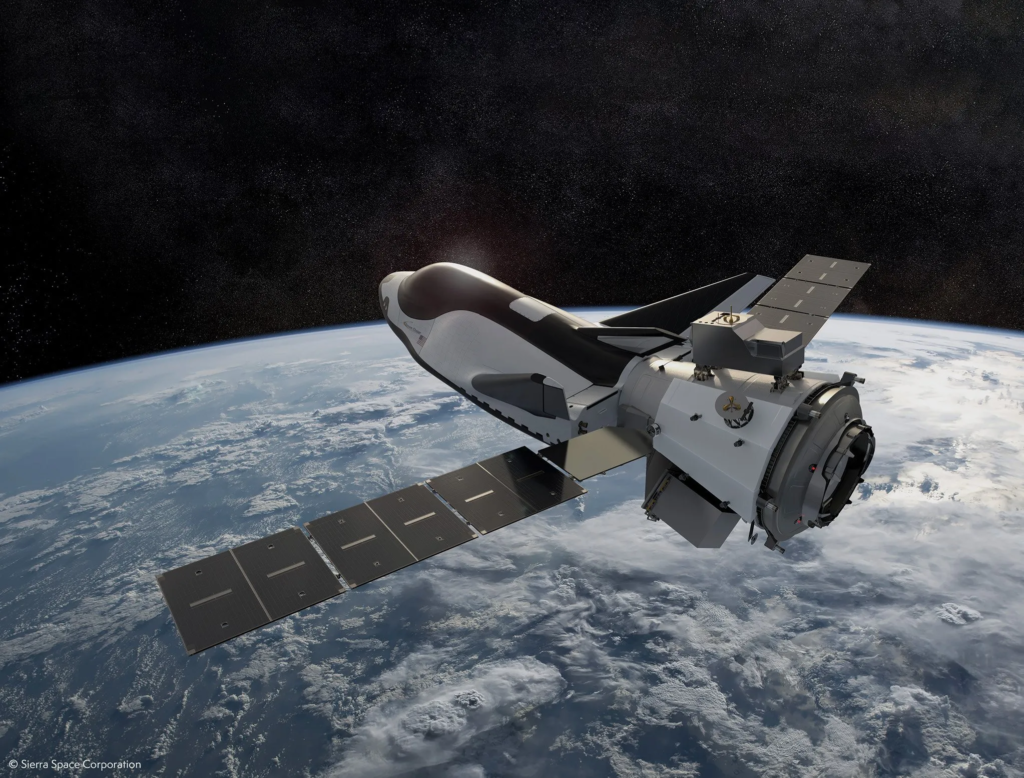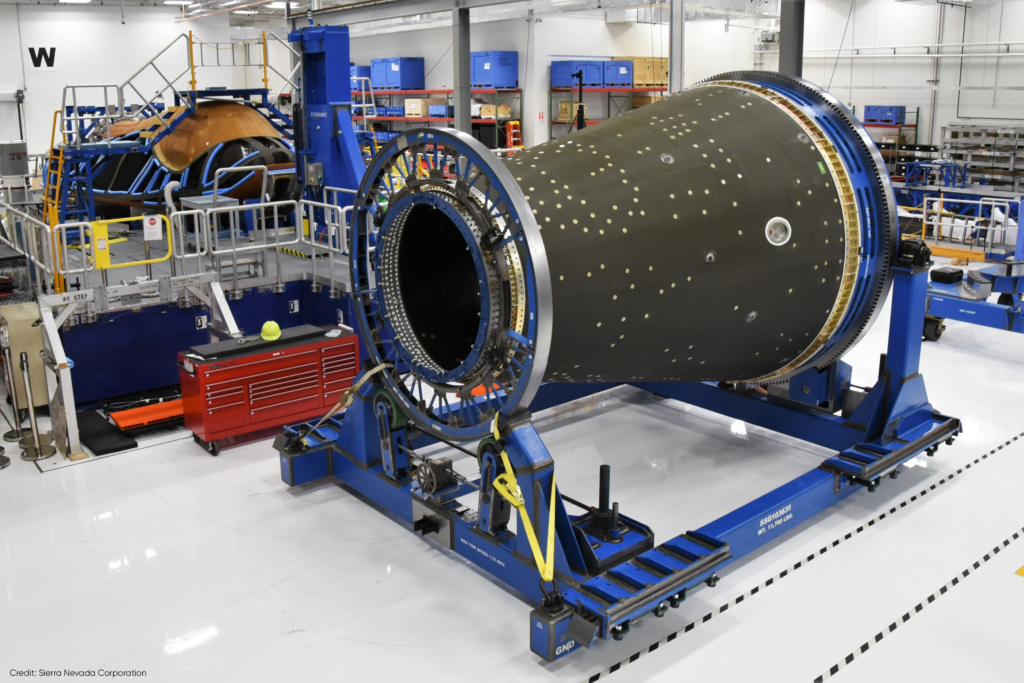
Why Dream Chaser’s Shooting Star Module Is So Important
After many years of development and testing, Dream Chaser’s first launch is scheduled to happen only months from now. As Sierra Space prepares, they are not only working on Dream Chaser Tenacity but also its Shooting Star transport vehicle. An equally important piece of equipment that changes what this spaceplane is capable of.
Shooting star is an extended module that attaches to the back of Dream Chaser. On a lot of future missions including the CRS flights with NASA, we can expect to see this hardware included. Some of its features include extra payload capacity, disposal services, power generation, and space, just to name a few. Unlike Dream Chaser, Shooting Star is meant to burn up in the atmosphere when its mission is complete.
This is why Sierra Space is working hard to innovate and create a capable design that can keep up with the future demand of Dream Chaser. For years now the company has been testing its materials and other important factors to try and create the most viable and effective hardware. Here I will go more in-depth into Shooting Star’s design, its importance for future Dream Chaser missions, what to expect in the coming months, and more.
Shooting Star Design

With Dream Chaser’s mission still scheduled for the third quarter of this year, we have been seeing an increase in updates on Dream Chaser Tenacity. Not only this, but on the 22nd, Sierra Space tweeted saying, “Shooting Star adds a service for NASA to send additional critical science, food, and cargo to the #space station. Once Shooting Star separates from Dream Chaser, the spaceplane glides gently back onto Kennedy Space Center’s runway.” This included an image of work being done to a Shooting Star module.
The overall goal for Dream Chaser is to be highly reusable, reduce overall cost, and provide quick turnarounds between missions. The ability to liftoff on top of multiple launch vehicles and land at a wide variety of runways is hoping to make Dream Chaser a flexible option for reliable transportation. Unfourtnealty, Dream Chaser is limited in size which has some negative effects when transporting cargo. Dream Chaser was originally designed as a crewed spaceplane, in part under NASA’s Commercial Crew Program, capable of carrying up to seven astronauts to and from the space station and other low Earth orbit (LEO) destinations. Dream Chaser is only 30 feet, or 9 meters long—roughly ¼ the total length of the space shuttle orbiters. This hurts its ability to not only bring enough cargo to destinations such as the ISS but also dispose of things as well.
Thankfully, with the help of the Shooting Star service module, Dream Chaser can deliver up to 5,500 kg of pressurized and unpressurized cargo to the space station, including food, water, supplies, and science experiments and returns to Earth. Specifically, Shooting Star adds a service for NASA to send additional critical science, food, and cargo to the space station. Crews can access the Shooting Star via the aft hatch, berthing to the space station. Traveling through the Shooting Star takes them to the forward portion where they can open the hatch and gain access to Dream Chaser. When attached to the space station, Shooting Star provides a normal cabin environment for astronauts to work, and a prime location for cargo to be removed and placed onto the station after berthing.
In addition, Shooting Star offers cargo disposal services for NASA. Once separated from Dream Chaser, the cargo module burns up safely in the Earth’s atmosphere and Dream Chaser glides gently back onto Kennedy Space Center’s runway. Since Shooting Star is disposed of on every CRS-2 mission, Sierra Space plans to maintain a production line to support all subsequent Dream Chaser missions. A task that is easier said than done considering the build and design of this module.
Dream Chaser’s Companion

Years ago in 2019, it was announced that an expendable Shooting Star cargo module would be part of the Dream Chaser cargo system for CRS-2 flights. The module is a 15-foot (4.6 m) long attachment to Dream Chaser that by itself will allow the spacecraft to carry an additional 10,000 pounds (4,500 kg) of pressurized and unpressurized cargo to ISS. In addition to carrying cargo, the Shooting Star module includes solar panels that supply up to 6 kW of electrical power. It also supplies active and passive thermal management; provides Dream Chaser translation & rotation capability via six mounted thrusters; and supports berthing or docking (in different configurations) to the ISS. Access from ISS to Dream Chaser will involve crew passing through Shooting Star (which supports a shirt-sleeve environment) and through a hatch that separates Shooting Star from Dream Chaser. Sierra Nevada says the module is capable of additional types of missions in LEO or to cis-lunar destinations; they have developed a free-flying variant with additional capabilities.
Not to mention, in July 2020, Sierra Nevada announced a contract with the Defense Innovation Unit (DIU) to use its Shooting Star expendable cargo vehicle as a possible commercial solution for a high-powered uncrewed orbital outpost. Around this same time, Sierra Space received its Shooting Star transport vehicle at the company’s Colorado production facility, marking the beginning of a key integration phase. This phase included installation of the SNC-built Passive Common Berthing Mechanism that will allow SNC’s Dream Chaser Tenacity spaceplane to berth to the International Space Station.
“This is a landmark milestone, not only for SNC, but for all of space exploration,” said SNC owner and CEO, Fatih Ozmen. “This state-of-the-art, mission-ready structure is a testament to SNC’s ability to deliver more capabilities to our customer without compromising on design,” she said. Built primarily from advanced composite materials, Shooting Star has a high strength-to-weight ratio, allowing it to achieve a high payload capacity to the space station. The structure was manufactured by subcontractor Applied Composites to SNC’s design requirements and shipped from its San Diego, California facility, to Louisville, Colorado. “I am very proud of both Applied Composites and my team,” said former NASA space shuttle commander and retired USAF pilot Steve Lindsey, now senior vice president of strategy for SNC’s Space Systems business area. “Not only did they complete crucial testing for Shooting Star on an accelerated timeline ahead of Shooting Star’s arrival in Louisville, but they innovated an entirely new approach to maintain the safety of both teams throughout the COVID-19 crisis.”
Shooting Star will now undergo integration with its subsystems before being delivered to NASA’s Plum Brook Station in Cleveland, Ohio for testing to ensure it can withstand both launch and space environments. In the middle of last year, it was announced that Spirit Defense & Space would assist in the development and production of future affordable Shooting Star Transport Vehicles under a Letter of Intent signed between the two companies. The agreement also provides for the two companies to work together to develop innovative technologies and processes to accelerate Sierra Space’s expanding Dream Chaser family of scalable spaceplanes to the market.
To be more specific, the two companies will work together to enhance the accessibility and efficiency of the Sierra Space Shooting Star cargo module system to advance a family of cargo and service modules for on-orbit services. The collaboration combines the strength of Sierra Space’s advanced space technology expertise with Spirit AeroSystem’s renowned aerospace industrialization proficiencies. “Through this long-term partnership, Sierra Space is delighted to begin work with Tom’s team at Spirit AeroSystems, widely recognized as leaders in the aerospace industry and aligned with our vision of an accessible and vibrant space economy,” said Sierra Space CEO, Tom Vice. “Working with Spirit Defense & Space, we will broaden access to tomorrow’s space economy; lowering the cost of entry and increasing the speed to market of Sierra Space’s Dream Chaser franchise. Together we will accelerate the commercialization of space.”
Initially, the partnership intends to establish production efficiency and integrated assembly solutions for Sierra Space’s Shooting Star cargo module, supporting resupply missions to the International Space Station (ISS) under the NASA Commercial Resupply Services 2 (CRS-2) contract. In relation to this, in November 2021, Sierra Space secured $1.4 billion in capital, the largest Series A capital raise in 2021 and the industry’s second largest private capital raise in history. The Series A investment was led by General Atlantic, Coatue and Moore Strategic Ventures, with participation from funds and accounts managed by BlackRock Private Equity Partners and AE Industrial Partners. The funding is accelerating the development of the company’s space transportation systems – led by the Dream Chaser® spaceplane, in-space destinations for LEO commercialization, and advanced technologies and space applications. An important factor as more Dream Chaser missions get scheduled in the future and the demand for Shooting star increases.
Conclusion
Shooting Star is a transport vehicle that makes Dream Chaser a much more capable spacecraft. With Dream Chaser featuring somewhat of a limited size and payload capacity, Shooting star is a great addition with extra benefits as well. We will have to wait and see how it progresses and the impact it has on the space industry.
